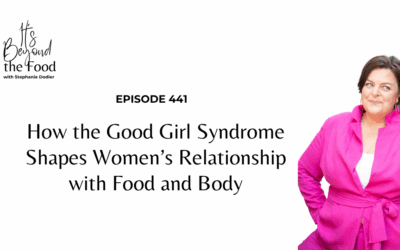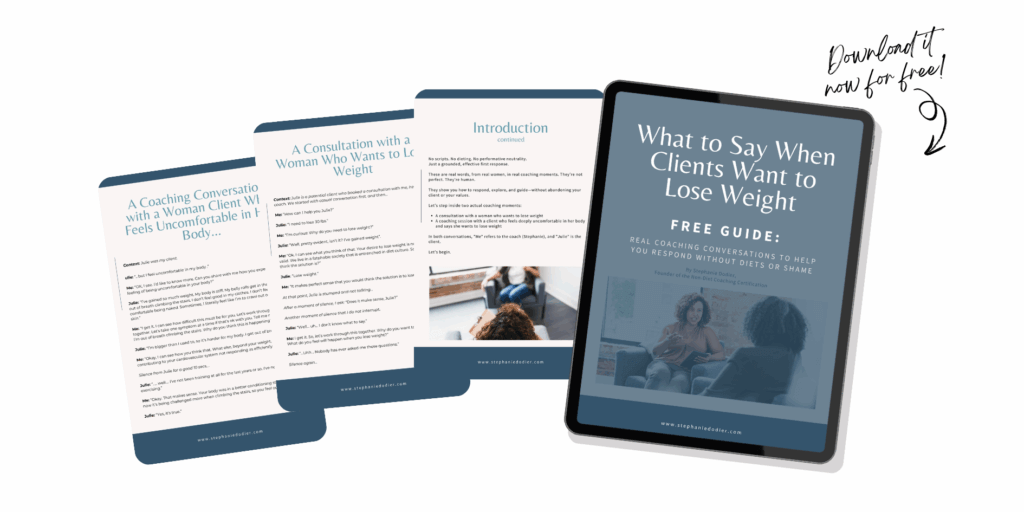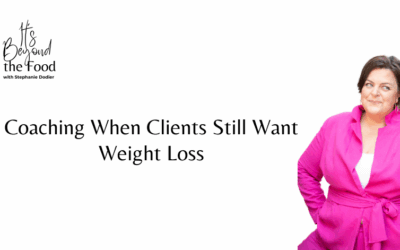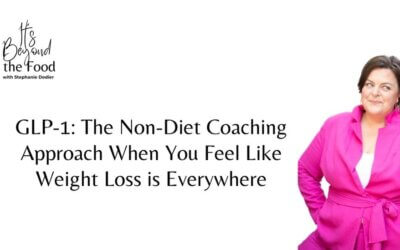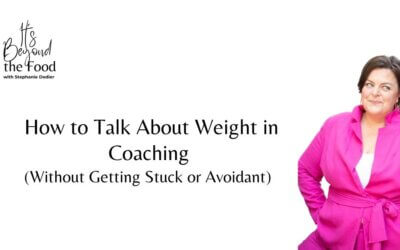Body Image Blogs
How the Good Girl Trauma Shapes Women’s Relationship with Food and Body
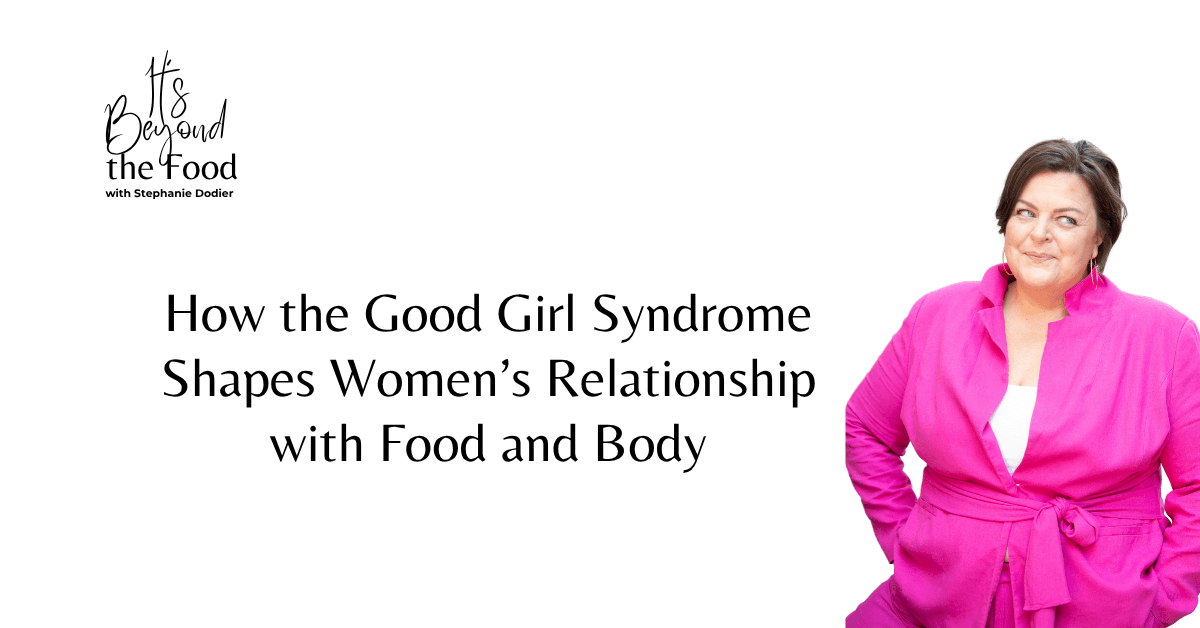

If you’re a health professional committed to coaching without co-opting diet culture, understanding Good Girl Trauma changes everything.
This trauma sits beneath many of the struggles your clients bring to you—food obsession, body dissatisfaction, burnout, perfectionism.
It’s not just about behavior; it’s about socialization. Women have been taught for generations that being “good” means self-denial, control, and compliance—and that belief quietly shapes how they eat, move, and care for their bodies.
Most women were raised to be “good girls.” Polite. Modest. Quiet. Helpful.
We learned early that our worth depended on how others perceived us—not how we felt about ourselves. This conditioning runs deep. It shapes our behavior, our confidence, and even our relationship with food and health.
What Is the Good Girl Trauma?
What many call the Good Girl Syndrome is better understood today as Good Girl Trauma—a psychological and social wound created by gendered expectations.
This trauma arises from the pressure to conform to deeply ingrained stereotypes of femininity: being agreeable, selfless, accommodating, and unproblematic. Under the surface of politeness and perfection, this conditioning erodes mental health and self-trust.
Good Girl Trauma often goes unnoticed because it hides behind what society rewards—compliance, caretaking, and achievement. It’s trauma disguised as success. It’s the exhaustion that comes from performing goodness rather than living authentically.
Over time, this pressure teaches women that love and belonging are conditional. To be accepted, we must not make mistakes, show anger, or take up too much space. We must constantly monitor how others feel about us. And that cycle—rooted in gender bias and reinforced by culture—quietly shapes every decision we make, including how we eat, move, and inhabit our bodies.
“Good Girl Trauma hides behind what society rewards—compliance, caretaking, and achievement. It’s trauma disguised as success.”
Common Signs of Good Girl Trauma
- Perfectionism: A belief that mistakes equal failure.
- Dependence on approval: Self-worth relies on praise and recognition.
- Fear of conflict: Disagreement feels unsafe, so we silence ourselves.
- Difficulty saying no: Boundaries feel selfish or risky.
- Excessive self-demand: The inner critic never rests.
- Emotional exhaustion: The pressure to appear “fine” leads to burnout and self-doubt.
Rather listen to the audio version of this blog? We’ve got you…
The Roots of Good Girl Trauma
To understand this trauma, we need to look at its origins. The “good girl ” archetype didn’t appear overnight—it’s centuries in the making.
Historical and Cultural Origins
The image of the “good girl” has deep roots in patriarchal structures and gender norms that dictated how women should behave. From fairy tales to religious teachings, women were taught that obedience, purity, and nurturing others defined their worth.
These messages created an enduring archetype: the woman who keeps everyone happy, asks for nothing, and sacrifices her own desires for the comfort of others.
Even today, these ideals linger. They influence how we parent, educate, and portray women in media. The “nice girl” may no longer wear a corset, but she still lives in the stories we tell and the standards we uphold.
Family Dynamics and Educational Systems
The pattern begins early. Girls are often praised for being quiet, cooperative, and helpful—while boys are encouraged to explore, debate, and take risks.
“Why can’t you be more like your sister? She always behaves.” “A polite girl doesn’t raise her voice.”
At home and in school, we internalize that good behavior equals love and safety. We learn that achievement and compliance bring praise, while assertiveness and self-expression invite criticism. The result? A lifelong fear of rejection and an instinct to prioritize others’ comfort over our own truth.
Media Influence
From childhood cartoons to women’s magazines, media reinforces these ideals.
The “good woman” is patient, nurturing, and self-sacrificing.
She gives, fixes, and smooths things over.
These portrayals shape not just what we see—but what we believe about ourselves. They create an invisible rulebook that measures our worth by how well we meet the impossible standard of being kind, thin, accommodating, and endlessly productive.
Growing Up to Fit the Mold
In my own life, being a “good girl” meant performing well and keeping everyone happy. I got good grades. I volunteered. I stayed quiet. I avoided standing out because being different felt unsafe.
One small moment stands out vividly. In seventh grade, I had hip surgery and spent three months at home. My parents hired a teacher to tutor me. One day, she told them my handwriting wasn’t “up to standard.” My letters were too big. My writing tilted slightly to the side.
That tiny critique turned into a family project to fix my handwriting. I remember sitting at the dining table, my parents hovering, as I practiced making my letters smaller and neater. The message was clear: don’t be different. Stay within the lines.
Not long after, my body changed—it no longer fit the “norm.” And just like that, I was taken to Weight Watchers.
That moment marked the beginning of a 25-year dieting career. The goal wasn’t health. It was conformity. I wanted to be a “good girl”—one who looked the way women were supposed to look.
Looking back, that moment wasn’t just about dieting—it was the beginning of my own Good Girl Trauma, where controlling my body became the proof that I was disciplined, worthy, and “good.”
“Controlling my body became proof that I was disciplined, worthy, and ‘good.’”
The Culture That Rewards Compliance
This isn’t just a personal story.
A Stanford University study found that the most desirable traits for women were compassionate, warm, cheerful, soft-spoken, and loyal.
For men, the top traits were independent, assertive, dominant, and decisive.
In short: women are valued for being soft; men for being strong.
And both sexes internalize this script. We grow up enforcing it—on ourselves and on each other.
Psychological Consequences of Good Girl Trauma
The mental health impact of Good Girl Syndrome runs deep. What looks like “having it all together” often masks anxiety, exhaustion, and a fragmented sense of self.
Mental Health Issues
- Anxiety: The constant fear of disappointing others or stepping out of line can be paralyzing.
- Depression: Suppressing your true self leads to emptiness and disconnection.
- Low self-esteem: Your worth feels conditional—based on approval rather than authenticity.
Struggle with Identity Formation
Good Girl Trauma creates a disconnect between who we are and who we think we should be.
We lose sight of our desires and instincts because they’ve been buried under performance.
- Conflicted self-identity: Torn between the authentic self and the “acceptable” self.
- Neglected interests: We abandon passions that don’t fit the image of the “good” woman.
Impact on Relationships
The trauma doesn’t just affect the self—it spills into relationships.
- Avoidance of conflict: Keeps relationships “peaceful” but shallow.
- Suppressed personality: Only the accommodating version of you is visible.
- Critical self-view: Frustration and shame amplify when you can’t meet impossible standards.
The Emotional Cost of Being a “Good Girl”
Good Girl Trauma teaches women to repress emotion. Anger, frustration, and grief are labeled “unfeminine.” So we turn inward, channeling pain into self-control or self-criticism.
Diet culture thrives in this silence. It tells women that emotional eating is weakness, that hunger is moral failure, that our body is a problem to be fixed. In truth, food often becomes the outlet for emotions we were never allowed to express.
We numb because we were never taught to feel. We overachieve because we were never taught to rest. We diet because we were taught to disappear.
How Good Girl Trauma Shapes Our Relationship with Food and Health
Good Girl Trauma doesn’t stop at emotional well-being—it infiltrates how women relate to food, health, and their bodies.
When we’re taught from childhood to suppress emotions and meet impossible standards, our body becomes the stage where that conflict plays out. We use control—of food, weight, and movement—to manage anxiety and maintain a sense of order in a world that demands perfection.
The thin ideal becomes the goalpost through which women prove they are “good.” A disciplined body signals compliance. A smaller body earns approval. And a body that resists shrinking becomes a source of shame.
For many, dieting begins as a socially sanctioned way to “be good.”
- Eating “clean” becomes proof of discipline.
- Pushing harder at the gym becomes a way to earn worth.
- Shrinking the body becomes a stand-in for shrinking emotional pain.
The result is not health—it’s disconnection. We lose trust in our bodies’ cues and confuse self-punishment with self-care.
In my work with women, this is often the turning point: realizing that their food and body struggles were never about willpower—they were about approval. Diet culture simply took the Good Girl script and sold it back as “wellness.”
Healing begins when we stop treating our bodies as projects to fix and start seeing them as partners in our recovery. When we rebuild trust with hunger, rest, and pleasure, we reclaim more than health—we reclaim autonomy.
“The thin ideal is the goalpost through which women prove they are good—discipline becomes morality, and shrinking becomes virtue.”
Coping Mechanisms and Unhealthy Behaviors in Good Girl Trauma
To survive the unrelenting pressure of perfection and approval, many women develop coping mechanisms. Some may look successful from the outside—but they often deepen the wound.
Common Coping Strategies
- Perfectionism: The endless pursuit of flawlessness to avoid criticism.
- Overworking: A constant drive to prove worth through productivity.
- People-pleasing: Prioritizing everyone else’s needs to maintain approval and safety.
Consequences of Maladaptive Coping
- Burnout: The inevitable crash from chronic overperformance.
- Neglect of personal needs: Health, joy, and rest are sacrificed for others.
- Relationship strain: Either overdependence on approval or emotional withdrawal.
The Cycle of People-Pleasing
If you struggle with people-pleasing, it’s not a character flaw—it’s a survival strategy. It was once how you stayed safe, loved, and accepted. But as adults, it becomes a cage.
Saying no feels like betrayal. Rest feels indulgent. And asserting needs feels wrong.
These learned patterns make it hard to set boundaries or care for ourselves without guilt. But awareness is the first step toward freedom.
The Duality Within
Inside many women lives a tension: the Good Girl we were taught to be versus the authentic woman we are becoming.
That duality explains why so many of us struggle with food, body image, and self-worth. The problem isn’t willpower—it’s the collision of conditioning and identity.
Once we recognize this, we can start rewriting the story.
“Healing from Good Girl Trauma isn’t rebellion—it’s reclamation.”
Reclaiming Our Power
Healing from Good Girl Trauma isn’t about rebellion—it’s about reclamation. We move from perfectionism to self-compassion. From compliance to authenticity. From managing others’ comfort to honoring our truth.
When we stop chasing approval, we reclaim our voice, our body, and our worth. And in doing so, we model something revolutionary for the next generation: that being a woman isn’t about being “good.” It’s about being whole.
Ready to Support Clients with Good Girl Trauma?
You can access all of our services on our work with us page. We have a number of programs and service levels enabling us to serve most women:
Free Resources and Masterclasses: Get started and get to know us better!
Private coaching with Stephanie and her team Stephanie and her team of Certified Non-Diet Coaches are waiting to support you in a one-to-one setting with an individualized plan.
Non-Diet Coaching Certification for professionals ready to integrate the Going Beyond The Food Method™️ in their practice and for women wanting to become a Certified Coach and build a business coaching other women beyond the food.
How to Coach Clients Through Weight Gain Without Prescribing Weight Loss Tactics Or Fear
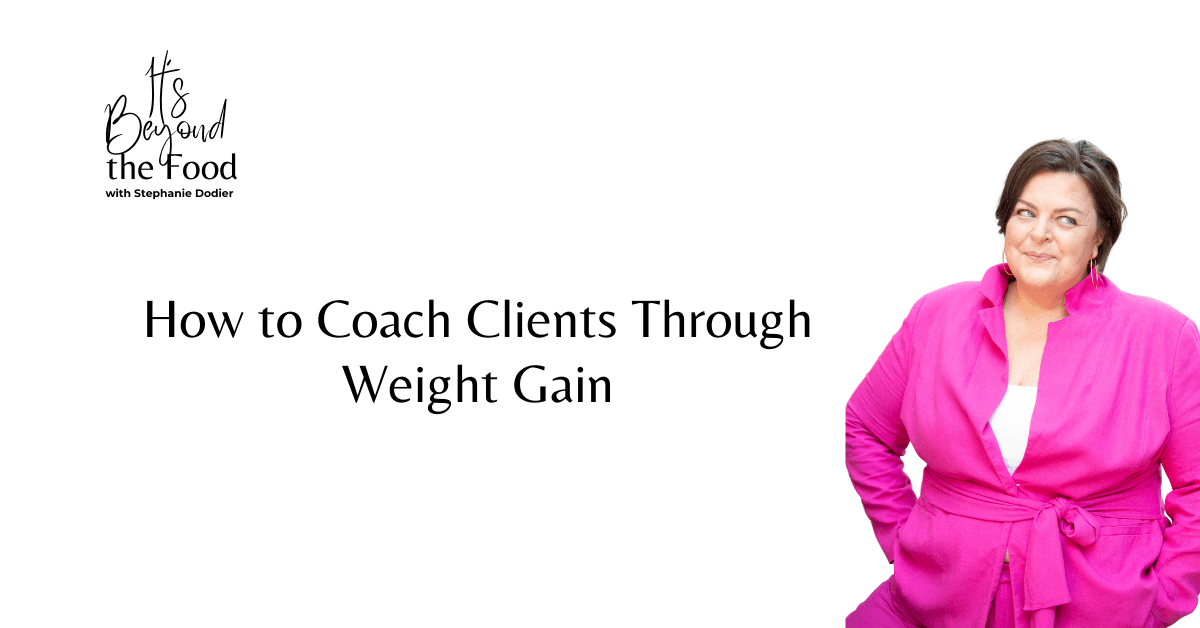

How do I coach a client who gains weight without selling a diet?
If you’ve ever asked yourself that, you’re not alone.
When your client gains weight during coaching, it can feel like the sky is falling—for them and for you.
They’re panicking. You might be panicking. And if you’re not careful, diet culture will sneak into your session and try to “fix” the situation by prescribing weight loss.
Let me be clear: weight gain is not a coaching emergency.
It’s a coaching opportunity.
And this blog will show you exactly how to navigate that moment powerfully, ethically, and without betraying your values.
First, Let’s Talk About You, Coach
It’s completely normal to feel shaken when a client wants to quit because of weight gain. You might feel like you failed them. Like you’re not a good enough coach. Like this weight gain is your fault.
It’s not.
Clients gaining weight isn’t a failure of your method—it’s a reflection of what happens when we untangle people from years of restriction, weight obsession, and diet trauma.
Before you coach your client through weight gain, you need to coach yourself. That means regulating your nervous system, noticing your thoughts, and holding your own discomfort with compassion.
You’re the container. Get grounded before you hold space for theirs.
Rather listen to the audio version of this blog? We’ve got you…
7 Steps to Coach Clients Through Weight Gain
This is the same process I teach inside the Non-Diet Coaching Certification. It’s trauma-informed, grounded in cognitive-behavioral principles, and built for real-world coaching.
1. Neutralize Weight Gain
Weight gain is not good or bad. It’s a neutral circumstance—just like your hair growing or your nails getting longer.
Start the conversation by helping your client see weight gain as neutral. Use analogies. Validate their distress without reinforcing fatphobia.
“What are you making this weight gain mean about you?”
2. Normalize the Distress (Without Colluding)
Yes, weight gain feels intense. Especially for those socialized as women. But your job is not to make it go away.
Your job is to hold space for the emotion without co-signing the belief that weight gain is inherently bad.
Acknowledge their despair. Then gently explore where it comes from.
“How has your identity shaped your beliefs about weight gain?”
3. Deconstruct Catastrophizing Thoughts
Fear tells your client that 15 pounds today means 500 pounds tomorrow. That’s catastrophizing. And it keeps them stuck.
Help them unpack their beliefs and fears one by one. Gently question the “truth” of their assumptions.
“Is it true that all these things will happen if your body changes?”
4. Regulate the Nervous System
No coaching breakthrough happens in a state of panic. Teach your client how to ride the wave of their emotion, not suppress it.
Use breathing, somatic grounding, and co-regulation to help them move from reactivity to response.
“Where do you feel that fear in your body? Let’s sit with it together.”
5. Offer New Solutions (Beyond Weight Loss)
Once they’re grounded, co-create new options:
- Body image healing (ex: body neutrality)
- Health-promoting behaviors without a weight focus
- Confidence work that isn’t body-dependent
This is the moment to remind them: their goals are still valid. And weight loss was never the goal of this coaching relationship.
And if you need help navigating these conversations? Download my free guide: What to Say When Clients Want to Lose Weight
6. Hold Space for Their Decision
This is where you step back. Don’t push. Don’t fix.
Let them choose how they want to move forward. Your job is to create the safest possible container for their autonomy—not your opinion.
“Which of these options brings you closer to the life you want?”
7. Coach Yourself, Too
Your client gaining weight will bring up your own fears: about money, credibility, retention, results. You need tools to regulate your nervous system and coach your own thoughts.
This is why self-coaching is part of our certification. Because how you experience a coaching rupture determines how safely you can guide your client through one.
Weight Gain Isn’t a Threat—It’s a Gateway
Most clients come to coaching because they’re stuck in a cycle. Weight gain is usually the trigger that got them to finally reach out.
When that fear shows up again during the work? That’s your moment.
This is where the transformation happens.
Can you meet them there, without flinching? Without trying to fix it with food rules or smaller-pants promises?
If yes, that’s the mark of a confident coach.
Ready to Coach Without Fear?
You can access all of our services on our work with us page. We have a number of programs and service levels enabling us to serve most women:
Free Resources and Masterclasses: Get started and get to know us better!
Private coaching with Stephanie and her team Stephanie and her team of Certified Non-Diet Coaches are waiting to support you in a one-to-one setting with an individualized plan.
Non-Diet Coaching Certification for professionals ready to integrate the Going Beyond The Food Method™️ in their practice and for women wanting to become a Certified Coach and build a business coaching other women beyond the food.
How to Coach Clients Who Still Want Weight Loss (without co-opting diet culture)
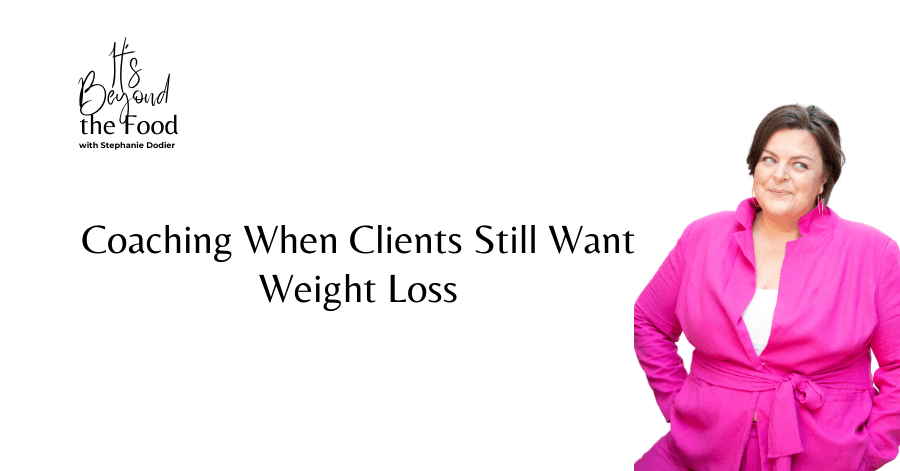

When a client says, “But I want to lose weight,” do you freeze up? Get a little panicky? Feel unsure how to respond without compromising your values?
You’re not alone.
If you’re a non-diet health coach, nutritionist, or therapist, these moments are inevitable. Weight loss will come up. It’s not a matter of if, but when.
What you do in that moment? That’s what defines your impact. And your client’s outcome.
In this guide, I’ll show you how to navigate those conversations without persuasion, shame, or silence. Instead, we’ll coach into the desire to lose weight—with clarity, confidence, and compassion.
Rather listen to the audio version of this blog? We’ve got you…
What Drives the Desire to Lose Weight?
The desire to lose weight isn’t a character flaw. It’s not even an objective fact. It’s a thought — one shaped by culture, identity, past experiences, and systemic oppression.
Clients don’t wake up one morning and randomly decide they should shrink their bodies. That desire emerges from layers of conditioning: diet culture, fatphobia, patriarchy, and healthism. Add to that personal history (like weight gain experiences or medical shaming), and it’s easy to see how the belief “I need to lose weight” becomes automatic.
The result? Thoughts like:
- I’ll get sick.
- I won’t fit in my clothes.
- My partner deserves better.
- People will think I’m lazy.
Which then trigger shame, disgust, or rejection, often driving clients right back into dieting, obsessing, or abandoning intuitive eating.
This cycle is powerful—but it can be interrupted. And that’s where coaching comes in.
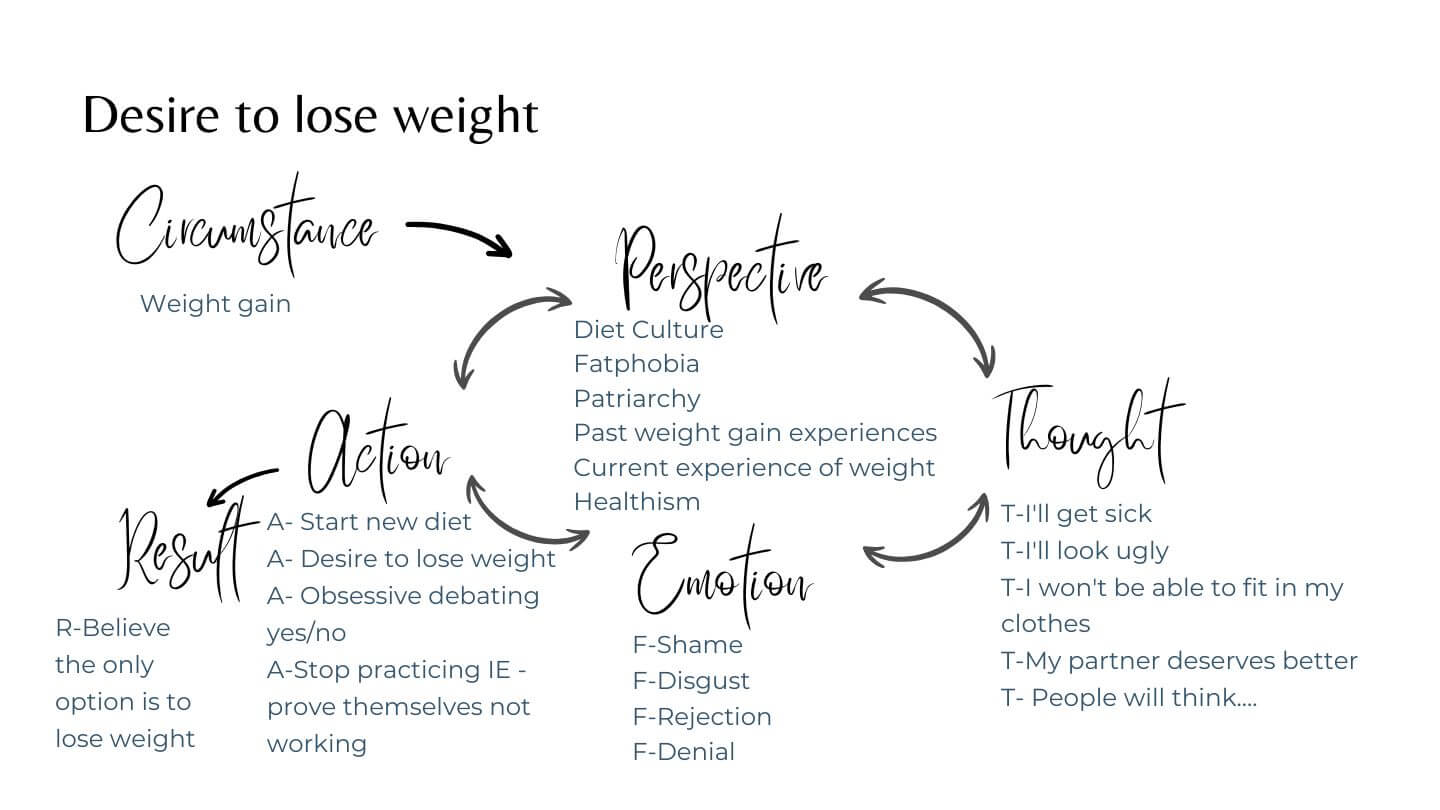

This visual framework captures how weight loss desire gets created and reinforced. It’s not proof that your client must lose weight. It’s a map showing the cultural, emotional, and behavioral forces at play. As coaches, we don’t fight the thought directly. We explore what’s underneath it.
From Panic to Curiosity: How to Respond
Your job is not to talk your client out of wanting to lose weight. It’s to explore why they want it.
Here are questions that move the conversation from fear to clarity:
- What are you hoping weight loss will do for you?
- If weight weren’t a factor, what would feeling good look like?
- What would being in a smaller body make possible?
- What do you think would change if weight wasn’t an issue anymore?
- Can we talk about what weight loss represents for you?
Remember: People don’t want the process of losing weight. They want the outcome they imagine is on the other side.
Confidence. Comfort. Acceptance. Health. Safety.
That’s the real coaching work.
What Putting Weight Loss “On the Back Burner” Actually Means
You’ve probably heard this advice before: “Put weight loss on the back burner.”
But here’s the nuance:
You’re not ignoring their desire. You’re just removing it from center stage.
Use This Analogy:
Imagine your client’s desire to lose weight is a pot of soup on the front burner. It’s been there for years, taking all the attention. What we do is move that pot to the back burner—still warm, still present—so we can cook something else at the front. Something like energy, joy, or freedom.
Use this coaching prompt:
“What if we gave the desire to lose weight less airtime? Not because it’s wrong—but because there’s more to you than your weight.”
Note: We teach this exact model inside the Non-Diet Coaching Certification, where coaches learn to meet this moment with skill, not silence.
The Motivation Trap: Why Weight Loss Goals Backfire
When weight loss is the motivator for behavior change, the client is stuck in an “if-then” trap:
- If I don’t lose weight, then it wasn’t worth it.
This type of extrinsic motivation is unsustainable. In contrast, intrinsic motivators like stress relief, energy, or joy drive long-term change.
A 2006 study on midlife women found that those who exercised for weight loss walked 2.5 times less than those motivated by energy or stress relief [Segar et al., 2006].
So when we shift the focus, we don’t just preserve body autonomy. We increase the likelihood of meaningful, lasting change.
For more on this, explore:
🎧 Listen here: How to be healthier without losing weight
How to be healthier without losing weight
🎧 Listen here: Weight neutral health pro and cons
Weight neutral health pro and cons
Your Client Wants What’s on the Other Side of Weight Loss
Here’s the truth:
Your client doesn’t want the diet. They want what they think the weight loss will give them.
That’s what we coach.
Here are some common “other side of the river” desires:
- Less physical pain
- Better mobility
- More energy
- Emotional safety
- Confidence
- Peace around food
- Social belonging
- Control over health
Help your clients see that these outcomes are available without shrinking their bodies.
And if you need a clear, harm-reducing way to frame this in session or consults, I created a free script for you: Download the guide.
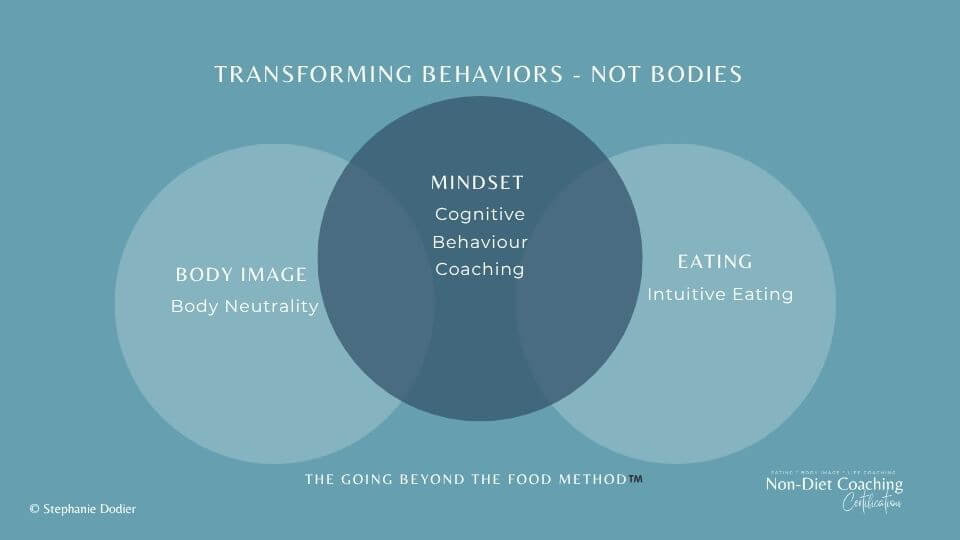

This is the foundation of our work: shifting from body control to behavior change. From managing appearance to cultivating resilience, energy, and trust.
Final Thoughts: This Is Our Coaching Moment
If we don’t meet the desire to lose weight with nuance and skill, someone else will. And likely with a diet plan.
We don’t coach bodies. We coach behaviors, beliefs, and the stories beneath them.
So let’s do it well.
If you’re ready to lead conversations that empower rather than persuade—to coach at the root instead of react to the symptom—join us inside the Non-Diet Coaching Certification.
That’s where we train professionals to do this work.
Need Help in Coaching Clients Who Still Want Weight Loss?
You can access all of our services on our work with us page. We have a number of programs and service levels enabling us to serve most women:
Free Resources and Masterclasses: Get started and get to know us better!
Private coaching with Stephanie and her team Stephanie and her team of Certified Non-Diet Coaches are waiting to support you in a one-to-one setting with an individualized plan.
Non-Diet Coaching Certification for professionals ready to integrate the Going Beyond The Food Method™️ in their practice and for women wanting to become a Certified Coach and build a business coaching other women beyond the food.
The GLP-1 Dilemma: A Weight-Neutral Coaching Approach
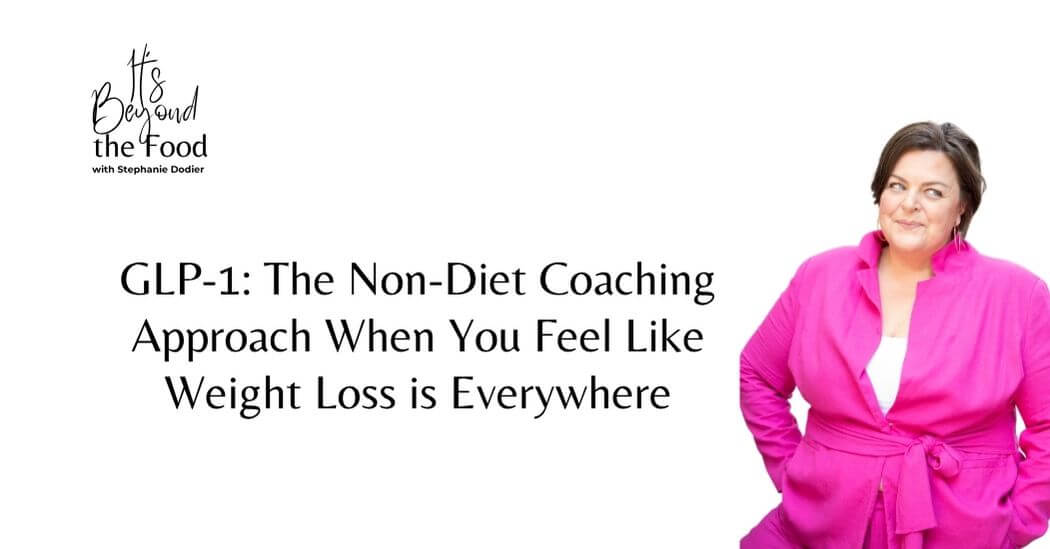

In today’s cultural climate, weight loss dominates nearly every health-related conversation. Whether it’s doctor recommendations, social media ads, or celebrity interviews, the pressure to shrink is ever-present. Now, with the soaring popularity of GLP-1 medications like Ozempic and Wegovy, that pressure has intensified.
For non-diet, weight-inclusive professionals, this can feel like an existential moment. Many are asking: How do I support my clients through this without abandoning my values? Can I remain weight-neutral while honoring someone’s interest in GLP-1s?
These questions mark a pivotal coaching evolution. Enter GLP-1 weight-neutral coaching—a framework that centers client autonomy, informed consent, and emotional safety.
The Moment We’re In
GLP-1 medications were originally developed to manage type 2 diabetes. However, when Wegovy received FDA approval for weight management in 2021, the conversation changed. These drugs began making headlines for their weight loss effects, prompting a rush of public interest.
Now in 2025, GLP-1s are everywhere. Many clients—even those who previously rejected diet culture—are reconsidering weight loss through a new, medicalized lens.
This shift is leaving many non-diet coaches feeling confused, silenced, or unsure how to respond. Some view it as a betrayal. Others retreat from the conversation altogether.
But avoidance isn’t neutral. Silence doesn’t serve your clients. And judgment won’t help them heal.
Rather listen to the audio version of this blog? We’ve got you…
What Is GLP-1 Weight-Neutral Coaching?
GLP-1 weight-neutral coaching provides an alternative path—one rooted in clarity, nuance, and respect. It rejects the binary of being “for” or “against” these medications. Instead, it offers tools to support clients in making truly autonomous health decisions.
This model is anchored in five key principles:
1. Anti-Oppression Lens
Coaching must recognize the social and systemic forces at play. Fatphobia, classism, and racism influence access to care and drive many people toward weight loss solutions. A weight-neutral coach works to resist these forces.
2. Bodily Autonomy
Every client has the right to make decisions about their body without coercion. Your role is not to approve or disapprove of their choice—it’s to create a safe space for exploration.
3. Intersectionality
Clients exist at the intersection of multiple identities. Race, gender, body size, disability, and financial status all shape their relationship to food and health. A GLP-1 conversation without acknowledging those realities is incomplete.
4. Collaboration
GLP-1 weight-neutral coaching is a shared process. Coaches don’t tell clients what to do. Instead, they co-create space for reflection, insight, and forward movement.
5. Cognitive-Behavioral Foundation
Instead of focusing solely on behavior (e.g., starting or stopping a drug), we examine the beliefs and emotions that drive it. What does the client hope to gain? What are they afraid will happen if they don’t lose weight?
The Coaching Opportunity Within the GLP-1 Conversation
Many coaches feel pressure to take a stance on GLP-1s. But that binary framing—approve or disapprove—misses the point. The real coaching opportunity lies in helping clients unpack the why.
What fear is driving the desire for weight loss? What past experiences are shaping their health choices today? What vision of wellness do they truly want to create?
Coaching questions that guide this inquiry may include:
“What are you hoping GLP-1 will solve for you?”
“If weight weren’t a factor, what would feeling good in your body look like?”
“Can we explore the possibility that you already know what you need?”
By helping clients move from fear into clarity, you offer them far more than a yes-or-no answer. You help them reclaim agency.
What the Research (Actually) Says
Most of the mainstream information about GLP-1s comes from pharmaceutical-funded studies. That means the data is often framed in ways that favor drug use.
Independent review shows:
Weight loss typically plateaus after one year of use.
Sustained weight loss requires continued medication use. Stopping often results in rebound weight gain.
74% of users report side effects, including nausea, diarrhea, and constipation.
Serious side effects—such as intestinal blockage or suicidal ideation—though rare, have been reported.
There is no unbiased long-term safety data for GLP-1s in general populations.
Cardiometabolic improvements appear to be linked to calorie restriction, not the drug alone.
Clients deserve access to this context. Tools like the patient-facing informed consent document created by Medical Students for Size Inclusivity can support this education process.
Coaching in Action: From Fear to Autonomy
Take the example of “Julie,” a 51-year-old woman recently diagnosed with prediabetes. Her doctor told her she had six months to “get it together,” or he’d prescribe GLP-1s. Terrified, she turned to coaching—not because she wanted a prescription, but because she didn’t want to become like her mother, who lives with chronic illness and limited mobility.
Julie’s fear wasn’t about vanity. It was about loss—of freedom, of identity, of life quality.
Through coaching, we unpacked her fear, discussed GLP-1 research, and explored weight-neutral health strategies. What emerged was a deeper understanding of her triggers, diet history, and emotional pain. Eventually, Julie chose a path of behavior change grounded in self-respect, not desperation.
This kind of transformation is only possible when coaching centers the person, not the medication.
The Business Side: Are You Reaching the Right Audience?
If your feed feels full of clients obsessed with GLP-1s, you may be speaking to people in the pre-contemplation or contemplation stages of behavior change. These individuals are still rooted in diet culture and may not be ready to explore weight-neutral frameworks.
Effective marketing for weight-neutral professionals speaks to people in the preparation or action stages—those who are curious, skeptical of the mainstream, and ready for something different.
This doesn’t mean you need to change your message. It means your messaging strategy might need refining.
GLP-1 as a Gateway, Not a Threat
GLP-1s are not the enemy. They are a gateway to deeper questions—questions about body trust, internalized beliefs, autonomy, and healing.
Your clients don’t need you to save them from GLP-1s. They need you to hold space for complexity, fear, and agency. They need you to help them find their voice again in a system that tells them they don’t know what’s best for their body.
That’s what GLP-1 weight-neutral coaching makes possible.
Final Thoughts
We are in a pivotal moment—one where weight loss is being rebranded as medicine, and autonomy is increasingly hard to hold. As coaches, we are uniquely positioned to resist coercion and champion client sovereignty.
GLP-1 weight-neutral coaching is not just a skill set. It’s a liberatory stance. It’s how we show up for our clients, for ourselves, and for the future of inclusive care.
If you’re ready to coach with nuance, courage, and clarity, this approach is for you.
Need Help with Weight-Neutral Coaching?
You can access all of our services on our work with us page. We have a number of programs and service levels enabling us to serve most women:
Free Resources and Masterclasses: Get started and get to know us better!
Private coaching with Stephanie and her team Stephanie and her team of Certified Non-Diet Coaches are waiting to support you in a one-to-one setting with an individualized plan.
Non-Diet Coaching Certification for professionals ready to integrate the Going Beyond The Food Method™️ in their practice and for women wanting to become a Certified Coach and build a business coaching other women beyond the food.
How to Have Weight Conversation in Health Coaching
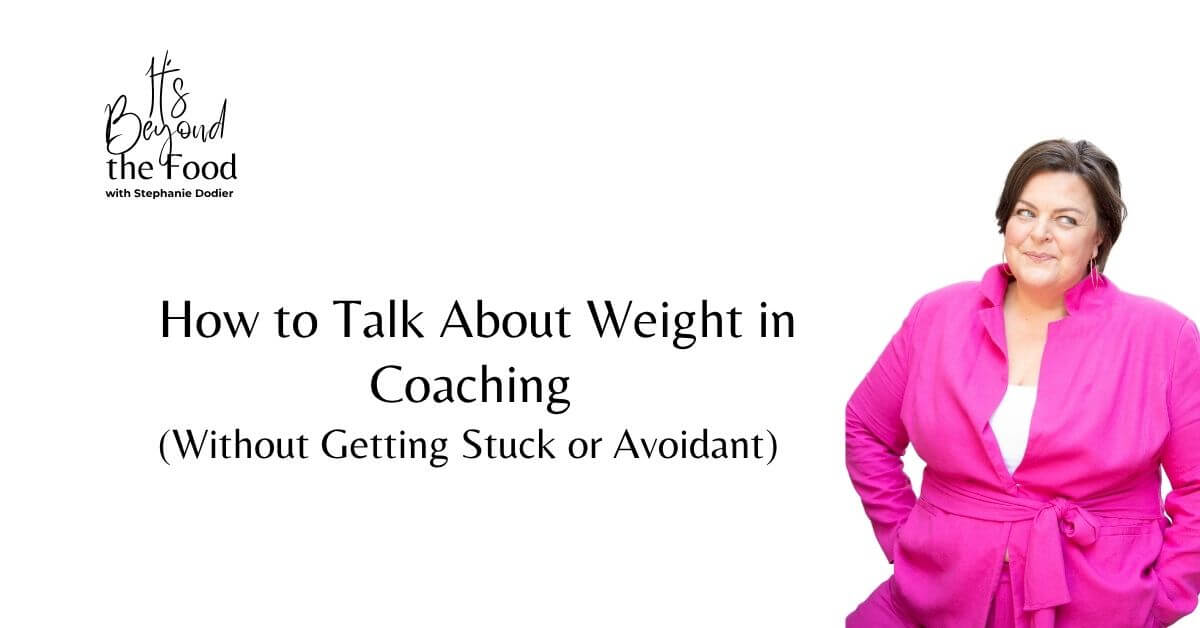

As health coaches committed to a non-diet approach, one of the most challenging conversations we face is when a client says: “But I need to lose weight.” Whether it’s during a consultation or mid-way through a coaching relationship, this statement can trigger fear, avoidance, or a rush to provide research.
Let’s reframe this moment. Instead of dreading the weight conversation in health coaching, let’s see it as an opportunity for deep, transformational work.
Why Talking About Weight Matters in Non-Diet Coaching
Many professionals freeze, intellectualize, or shut down when a client mentions weight. This reaction is normal—but not useful. We cannot guide our clients toward body acceptance and sustainable health if we can’t hold space for their real concerns.
Weight, for most clients, isn’t the problem. It’s the symbol of deeper emotional and social pain—fear of rejection, desire for belonging, or hope for improved health. Our role as coaches is not to convince them otherwise with science but to create space for their truth and gently guide them toward self-discovery.
Rather listen to the audio version of this blog? We’ve got you…
Step 1: Recognize Weight Talk as a Portal, Not a Problem
When clients express concerns about weight—be it weight loss or gain—it’s rarely about the number on the scale. Rather, it’s a surface symptom of deeper discomfort: a desire to feel safe, accepted, healthy, or less judged. The key is recognizing that weight talk is a symbol of underlying emotional, social, or physical distress. Avoiding it only reinforces shame. Instead, lean in.
Coaching isn’t about correcting beliefs with facts. It’s about exploring and unraveling them with empathy.
Step 2: Examine Your Own Relationship With Weight
Before you can effectively coach others through their body image struggles, you must unpack your own. Do weight-related comments from clients trigger discomfort, defensiveness, or judgment in you? That reaction is a cue—not a flaw. It points to areas within yourself that are still healing.
Until you can hold space for your client’s desires without attaching moral value, your nervous system will likely transmit subtle cues of discomfort. And clients are incredibly perceptive.
Step 3: Normalize, Then Get Curious
When a client says, “I need to lose weight,” your role is not to correct or convince, but to inquire. Start by normalizing their experience:
“It makes total sense that you feel this way, given what you’ve been taught about bodies and health.”
Then, dig deeper. Powerful coaching questions help clients uncover the true motives and fears driving their desire for weight change:
What does losing weight mean to you?
What do you believe will change when your body is smaller?
What makes this desire feel urgent right now?
What are you making this weight gain/loss mean about who you are?
These questions do more than gather information—they shift the client from reacting to reflecting.
Step 4: Identify the Real “Why”
As clients unpack their thoughts, patterns emerge. Most often, the weight concern isn’t about weight at all. It’s about:
Wanting to feel confident in public
Fear of rejection or not being loved
A need to avoid illness or reverse chronic symptoms
Pressure from medical providers or family
Wanting to reclaim energy and vitality
Weight becomes a scapegoat for these fears, because diet culture has conditioned us to believe it is the root of all suffering—and that changing our body is the solution.
Step 5: Lead with Compassion, Not Correction
Once the deeper drivers are revealed, mirror them back. Not as a rebuttal, but as recognition:
“If I’m hearing you correctly, it sounds like the desire to lose weight is really about wanting to feel in control of your health and avoid judgment from others.”
This is your opening to gently introduce new perspectives—around health at every size, intuitive eating, and body neutrality—without invalidating the client’s lived experience. This isn’t about preaching. It’s about offering an alternative lens.
Step 6: Explore the Pattern, Not Just the Problem
Rather than trying to change the client’s mind, guide them through examining past attempts:
When was the last time you successfully lost weight?
How did you do it?
Did it last?
Did you enjoy the process?
This helps clients see their own patterns and gently question whether weight loss is truly the solution—or just a familiar cycle with predictable disappointment.
From here, you can offer a radical alternative:
“What if you could feel more confident, energized, and in control—without having to change your body?”
This reclaims the conversation and offers clients a sense of possibility they may not have considered.
Embracing the Discomfort to Facilitate Change
The weight conversation in health coaching is not a detour—it’s the work. Holding space for clients’ weight concerns with empathy, curiosity, and skill allows for true transformation. When clients feel seen and heard—not shamed or dismissed—they’re far more open to shifting perspective. If you’d like to see how I facilitate this conversation, I created this guide: What To Say When Clients Want to Lose Weight.
This framework doesn’t eliminate discomfort. But it equips coaches to move through it with grace, purpose, and confidence. In doing so, we not only support our clients’ healing—we deepen our own.
Need Help with Weight Conversation in Health Coaching?
You can access all of our services on our work with us page. We have a number of programs and service levels enabling us to serve most women:
Free Resources and Masterclasses: Get started and get to know us better!
Private coaching with Stephanie and her team Stephanie and her team of Certified Non-Diet Coaches are waiting to support you in a one-to-one setting with an individualized plan.
Non-Diet Coaching Certification for professionals ready to integrate the Going Beyond The Food Method™️ in their practice and for women wanting to become Certified Coach and build a business coaching other women beyond the food.
Health Coach—Should You Stop Selling Weight Loss?


As a health coach, the question of whether to stop selling weight loss is one that touches not just your business but also your values and ethics. For many, weight loss programs seem like a natural fit because “it’s what sells” or “it’s what clients want.” But is selling weight loss really aligned with what you believe in?
This guide is for health coaches considering the transition to non-diet health coaching. We’ll dive into the ethical and emotional challenges of stepping away from weight loss-focused programs, share real conversations from the field, and provide a roadmap for creating a business that’s values-aligned and impactful.
Health Coaching Selling Weight Loss: Why It Feels Safe
Let’s start by acknowledging the reality: in a fatphobic society, weight loss is seen as a desirable outcome. From social media influencers to healthcare professionals, the pervasive message is that shrinking your body equals success, health, and happiness.
As coaches, we’re taught to “sell people what they want and give them what they need.” For many of us, that’s meant marketing weight loss programs to draw clients in, even if we later shift the focus to sustainable, non-diet approaches.
But here’s the thing: this model perpetuates harm.
Every time you market weight loss, you reinforce the narrative that something is wrong with your clients’ bodies. You’re not just selling a program—you’re upholding the oppressive systems of diet culture and fatphobia.
A Conversation That Changed Everything
During a recent body image coaching mentorship, I had a powerful conversation with a client about this very topic:
Client: “I wish I could join the Non-Diet Certification, but you don’t accept people who sell weight loss.”
Me: “Interesting. Why do you sell weight loss?”
Client: “Well, you know, that’s what sells. That’s what women want.”
Me: “Do you believe in the process of dieting and the sustainability of intentional weight loss long term?”
Client: “No, I don’t, and that’s why I give them the Non-Diet approach when they start working with me.”
Me: “I see. May I ask then why you are here learning from me about body image coaching?”
Client: “Well, it’s because my clients really struggle with accepting their bodies. I need to get better at helping them.”
Me: “So let me make sure I understand: you don’t believe in dieting or intentional weight loss. You don’t coach your clients to use dieting tactics. You’re here learning from a fat nutritionist and interested in advancing your skills. The only thing between you and your desires is releasing weight loss as a promise. Why do you think you’re resisting?”
Client: Silence. “I’m afraid of what will happen.”
Health Coaching Selling Weight Loss: The Fear of Letting Go
That fear is real—and valid. We live in a culture that rewards weight loss marketing with clicks, sign-ups, and praise. Moving away from selling weight loss can feel like stepping off a cliff without a safety net.
For many, the fear stems from internalized fatphobia and the belief that clients won’t invest in programs that don’t promise weight loss. This fear often manifests as:
- Worry about losing clients.
- A dip in revenue during the transition.
- Uncertainty about how to market non-diet services.
A Personal Journey: Trusting Your Values
I’ve been there. Eight years ago, I was a nutritionist selling weight loss programs despite not believing in their long-term effectiveness. I felt stuck, scared, and unsure of how to move forward without compromising my integrity.
But I made the leap. I stopped selling weight loss, embraced non-diet health coaching, and built a business rooted in my values. Was it easy? No. Was it worth it? Absolutely.
Here’s what I’ve learned:
- Trusting your intuition and aligning with your values is the foundation for sustainable success.
- Your ideal clients—the ones ready to do meaningful work—will find you.
- Stepping away from weight loss programs allows you to create deeper, more fulfilling client relationships.
What Happens When You Stop Selling Weight Loss
When coaches transition to non-diet health coaching, they often report significant positive shifts in their business and personal fulfillment:
- “I’m calling in my ideal clients who are ready to do the work.”
- “I stopped selling weight loss, and my program packages are selling better.”
- “I’m working with clients who are fun to coach and aligned with my values.”
- “I feel confident and clear in my business decisions.”
Why Non-Diet Coaching Works
Non-diet health coaching isn’t about ignoring health or behaviors—it’s about focusing on sustainable changes that don’t hinge on weight loss. Clients learn to:
- Build healthier relationships with food.
- Explore movement that feels joyful, not punishing.
- Develop self-compassion and body acceptance.
By shifting the focus away from weight loss, you empower clients to make changes rooted in self-care, not shame.
Health Coaching Selling Weight Loss: Practical Steps to Transition to Non-Diet Coaching
If you’re ready to stop selling weight loss, here’s how to begin:
- Clarify Your Values: What do you stand for as a coach? Write down your values and let them guide your decisions.
- Educate Yourself: Learn the principles of non-diet coaching and health at every size (HAES).
- Audit Your Marketing: Remove language that promises weight loss and replace it with messaging about sustainable health and well-being.
- Address Your Fears: Reflect on what’s holding you back and seek support from mentors or peers.
- Lean into Community: Surround yourself with other non-diet professionals who can offer guidance and encouragement.
Health Coaching Selling Weight Loss: Is It Time to Stop Selling Weight Loss?
Ultimately, the decision to stop selling weight loss is deeply personal. It requires courage, reflection, and a willingness to disrupt the status quo. But the rewards—both for your clients and your business—are profound.
By letting go of weight loss as a promise, you free yourself to build a coaching practice that aligns with your values and supports lasting change.
Are you ready to make the leap?
Need Help Transitioning to Non-Diet Health Coaching?
You can access all of our services on our work with us page. We have a number of programs and service levels enabling us to serve most women:
Free Resources and Masterclasses: Get started and get to know us better!
Private coaching with Stephanie and her team Stephanie and her team of Certified Non-Diet Coaches are waiting to support you in a one-to-one setting with an individualized plan.
Non-Diet Coaching Certification for professionals ready to integrate the Going Beyond The Food Method™️ in their practice and for women wanting to become Certified Coach and build a business coaching other women beyond the food.
We Need Thin Weight Neutral Health Coaches and Providers


The weight-neutral health coaching space is a movement that’s transforming how we approach health and well-being. At its core, this philosophy embraces health at every size, rejecting the traditional focus on weight loss as a measure of success.
While the space has grown significantly, an important conversation remains: the role of thin weight-neutral health coaches and providers. This essay explores why we need people of all body sizes in this space, especially thin providers, and how they can use their position to create meaningful change.
What Does It Mean to Be a Weight-Neutral Health Coach?
Weight-neutral health coaches prioritize behaviors over outcomes. Instead of promoting weight loss, they focus on sustainable habits like intuitive eating, joyful movement, and stress management. This approach helps clients improve their health and relationship with their bodies without fixating on the scale.
For weight-neutral coaching to truly thrive, it requires diversity among its providers. That means welcoming coaches of all body sizes—thin, fat, and everything in between.
Why Thin Coaches Are Vital to the Weight-Neutral Space
There’s a misconception circulating that thin coaches don’t belong in weight-neutral spaces because they benefit from thin privilege. However, this perspective oversimplifies the impact thin coaches can have.
1. Representation Matters: Clients entering the weight-neutral space for the first time may feel more comfortable with a thin coach, especially if they have internalized fatphobia. For some, seeing someone they perceive as “acceptable” can create a bridge to understanding.
2. Leveraging Privilege for Good: Thin coaches have a unique ability to acknowledge and challenge the privileges they benefit from, creating safer spaces for clients in larger bodies.
3. Expanding the Movement: The inclusion of thin coaches helps normalize the idea that weight-neutral approaches are for everyone, not just people in larger bodies.
Rather watch the video version of this blog post? We’ve got you…
I recorded a podcast episode a few years back where we discuss thin privilege in health coaching with Alissa Rumsey and Julie Duffy Dillon.
Understanding Thin Privilege in Weight-Neutral Coaching
Thin privilege is the societal advantage people in smaller bodies have simply because they fit the cultural ideal. It shows up in ways like:
- Being accommodated in public spaces.
- Having access to clothing that fits.
- Not facing discrimination from healthcare providers.
In weight-neutral health coaching, thin privilege can impact the client relationship. To foster trust, it’s essential for thin coaches to acknowledge and address this dynamic openly. Doing so creates an environment where clients in larger bodies feel seen and respected.
My Personal Journey with Thin Coaches
Nine years ago, as I began recovering from diet culture, I was hesitant to work with a fat coach. My internalized fatphobia was so strong that I couldn’t face my own body reflected back to me during coaching sessions.
Instead, I found my first weight-neutral health coach in a thin-bodied woman. She had never struggled with body image the way I had, but she held a safe space for me when I couldn’t do that for myself. She taught me to process emotions, practice self-compassion, and confront my internalized fatphobia.
That coach was the catalyst I needed to eventually work with someone in a larger body. Without her, I wouldn’t have been ready to take the next step in my journey.
How Thin Weight-Neutral Coaches Can Support Clients of All Sizes
If you’re a thin coach or provider entering the weight-neutral space, here are actionable steps to ensure you’re creating inclusive, empowering spaces for your clients:
1. Acknowledge Your Privilege: Be transparent about the advantages you’ve experienced in your body. Naming this privilege helps build trust.
2. Hold Safe Space: Learn how to create an environment where clients feel supported and validated, regardless of their size.
3. Educate Yourself: Understand the unique challenges faced by people in larger bodies, including systemic fatphobia and weight stigma.
4. Use Your Voice: Advocate for body diversity and weight-neutral approaches in professional spaces and on public platforms.
5. Practice Self-Compassion: If you feel guilt about your privilege, channel it into positive action instead of self-criticism.
Training Weight Neutral Coaches: The Skills That Matter
To be an effective weight-neutral health coach, whether thin or fat, you need more than good intentions—you need skills. Some essential coaching skills include:
- Understanding Belief Systems: Helping clients uncover and change harmful thoughts about their bodies.
- Nervous System Regulation: Teaching clients how to manage stress and emotions in a way that supports long-term health.
- Creating Safe Spaces: Building environments where all clients feel respected and empowered.
- Intersectional Coaching: Recognizing how factors like race, gender, and socioeconomic status intersect with body size and health.
The journey to becoming a skilled weight-neutral coach begins with doing the work on yourself first. By examining your own biases, beliefs, and behaviors, you can show up authentically for your clients.
Why Diversity Strengthens the Weight-Neutral Movement
Diversity in coaching bodies isn’t just a bonus—it’s a necessity. Having coaches of different sizes, experiences, and backgrounds enriches the movement and ensures it meets the needs of all clients.
Thin weight-neutral coaches bring the ability to bridge gaps for clients who might not be ready to confront internalized fatphobia. Fat coaches offer lived experience and insights that thin coaches simply can’t replicate. Together, they create a more inclusive, powerful movement.
Weight Neutral Health Coaches: A Call to Action
If you’re a thin coach considering entering the weight-neutral space, know this: your presence matters. You have the potential to make a profound impact on your clients’ lives by challenging diet culture and promoting true health.
Likewise, if you’re a client seeking a weight-neutral coach, remember that the right coach for you might not look the way you expect. What matters most is their ability to create a safe, supportive space for your journey.
The weight-neutral health coaching movement needs all of us—thin, fat, and everything in between. Together, we can challenge societal norms, reject diet culture, and create a world where health is accessible to everyone, regardless of body size.
How We Can Help You Become a Weight-Neutral Coach
You can access all of our services on our work with us page. We have a number of programs and service levels enabling us to serve most women:
Free Resources and Masterclasses: Get started and get to know us better!
Private coaching with Stephanie and her team Stephanie and her team of Certified Non-Diet Coaches are waiting to support you in a one-to-one setting with an individualized plan.
Non-Diet Coaching Certification for professionals ready to integrate the Going Beyond The Food Method™️ in their practice and for women wanting to become Certified Coach and build a business coaching other women beyond the food.
Thinking About Going Back on a Diet to Lose Weight? Read This!


A Guide for Women Triggered by Diet Culture
This guide is for every woman who’s felt triggered by diet culture recently and are thinking about going back on a diet:
- The influencer flaunting their “healthy lifestyle transformation.”
- The gym windows showcasing “before and after” photos.
- Aunt Janice bragging about her miracle weight loss program.
If you’ve caught yourself thinking about going back on a diet, know this: your thoughts are valid and expected. You’re not broken or weak. You’re simply living in a world that constantly reinforces the idea that your body needs to change.
Let’s unpack these triggers together, so you can move past the noise of diet culture and reclaim your power.
Thinking about Going Back on a Diet: How To Coach Yourself When Triggered by Diet Culture
When you think about dieting, it’s often your brain’s way of seeking safety in a fatphobic society. The messaging around us equates thinness with happiness, success, and health. It’s no wonder you feel compelled to change your body—it’s what you’ve been taught for years.
But here’s the truth: a thought is not a fact.
That fleeting desire to lose weight? It’s not an absolute truth about your worth or what you need to feel fulfilled. It just reflects the conditioning you’ve absorbed from diet culture.
Step 1: Normalize Your Thoughts
The first step in navigating these feelings is normalization. Remind yourself that it’s normal to think about dieting in a world obsessed with thinness.
Try saying this to yourself:
“It makes total sense that I feel this way. I live in a fatphobic, diet-culture-obsessed society.”
Place your hand on your heart, breathe deeply, and repeat it with compassion. This simple act can help shift your mindset from self-blame to understanding.
Step 2: Challenge Your Beliefs
After normalizing your thoughts, ask yourself:
- What do I want to believe about my body, health, and happiness?
- Do I want to keep believing that weight loss is the key to my happiness or health?
Diet culture thrives on three major lies:
- Smaller bodies are better and more valuable.
- Health is only accessible at a smaller weight.
- Your worth depends on how hard you work to shrink your body.
Now, let’s rewrite the narrative. Consider these alternative beliefs:
- My body is a tool to experience life, not a sign of my worth as a woman.
- Health-promoting behaviors are accessible at any weight.
- My happiness comes from the way I think about myself, not my pant size.
Step 3: Choose Empowering Thoughts
Once you’ve identified the beliefs you want to hold, it’s time to train your brain to think them more often. This is where true transformation begins, but it requires practice and patience.
Here’s how:
- Write down your new beliefs.
- Place them somewhere visible—on your mirror, fridge, or phone wallpaper.
- Repeat them daily, even if they don’t feel true right away.
Over time, these new thoughts will become second nature, replacing the diet culture beliefs that once dominated your mind.
Why Going Back on a Diet Feels So Tempting
Dieting provides a sense of control, especially when life feels overwhelming. It offers a clear path with rules and promises of a better future. But here’s what diet culture doesn’t tell you:
- Diets fail 91-95% of the time.
- They create a cycle of weight loss and regain, leaving you feeling like the problem when the real issue is the unsustainable methods.
- Dieting harms your relationship with food, your body, and your mental health.
You’re not the problem. Diet culture is.
Step 4: Reflect on What You’re Truly Seeking
When you think about dieting, it’s rarely just about the weight. Ask yourself:
- What am I hoping to feel by losing weight?
- Do I want confidence, happiness, ease, or acceptance?
The good news? You don’t need to shrink your body to feel those things. Confidence and happiness are already within reach—you just need to shift the focus from external validation to internal growth.
Step 5: Break Free with Self-Compassion
Breaking free from diet culture is not a one-time decision. It’s an ongoing process of self-coaching and self-compassion. Here’s how to stay grounded when triggers arise:
- Acknowledge Your Triggers: Recognize when a comment, ad, or thought activates your desire to diet.
- Pause and Breathe: Create space between the trigger and your response.
- Respond with Kindness: Remind yourself that it’s normal to feel this way, but you have the power to choose a different path.
Thinking about Going Back on a Diet: What to Do Instead
Instead of focusing on weight loss, channel your energy into behaviors that genuinely improve your well-being.
1. Focus on Nourishment: Eat foods that satisfy and energize you, without labeling them as “good” or “bad.”
2. Move for Joy: Find activities that make you feel alive and connected to your body, rather than punishing workouts.
3. Prioritize Rest and Stress Management: Sleep and stress reduction are critical for physical and emotional health.
4. Celebrate Your Body: Practice gratitude for what your body allows you to do, rather than how it looks.
Remember: You Are Enough
When you feel the urge to go back on a diet, remind yourself:
- You don’t need to fix yourself.
- Your body is not a problem.
- Diet culture doesn’t get to define your worth.
Choosing to reject dieting is a radical act of self-love in a world that profits from your self-doubt. By reclaiming your thoughts, beliefs, and behaviors, you can liberate yourself from the endless cycle of dieting and finally live fully.
How We Can Help
You can access all of our services on our work with us page. We have a number of programs and service levels enabling us to serve most women:
Free Resources and Masterclasses: Get started and get to know us better!
Private coaching with Stephanie and her team Stephanie and her team of Certified Non-Diet Coaches are waiting to support you in a one-to-one setting with an individualized plan.
Non-Diet Coaching Certification for professionals ready to integrate the Going Beyond The Food Method™️ in their practice and for women wanting to become Certified Coach and build a business coaching other women beyond the food.
Navigating Diet Talks and Comments about Weight & Body


A Guide for Women
In a world preoccupied with appearance and weight, navigating diet culture and unsolicited body commentary can be challenging. Many women face these conversations in social, family, and professional settings, making it essential to develop strategies to maintain self-confidence and emotional well-being. This guide offers insights into understanding diet culture, managing emotional triggers, and setting boundaries to foster empowerment.
Understanding the Context of Diet Talks and Body Comments
The Pervasiveness of Diet Culture
Diet culture is a societal framework that equates thinness with health, morality, and success. This narrative often influences conversations about weight, food, and bodies, leaving many unaware of its insidious effects. Women, particularly, are often targeted, expected to conform to unrealistic body standards shaped by patriarchal norms.
Recognizing the systemic nature of diet culture can help shift perspectives. The comments you hear or the comparisons you make are products of a deeply ingrained belief system, not personal truths.
Rather listen to the audio version of this blog? We’ve got you…
Preparing for Diet and Body Discussions
Anticipate the Conversations
Diet-related discussions tend to surface during holidays, family gatherings, and even casual meet-ups. Rather than being caught off guard, anticipate these topics and prepare mentally. Understand that people may not have the same awareness of diet culture as you do, and many speak from a place of conformity rather than intent to harm.
Mindset Shift: View these interactions as predictable events rather than personal attacks. This reframing can lessen their emotional impact.
Managing Emotional Reactions to Body Comments
Recognizing the Source of Your Emotions
Emotional responses to body-related comments often stem from internalized beliefs rather than the words themselves. For instance, a remark about weight gain might trigger self-doubt because it aligns with existing insecurities. However, these emotions are self-generated by how we interpret others’ words.
Actionable Step: Pause when faced with triggering comments. Ask yourself, “What belief am I holding onto that makes this comment hurtful?” This reflection redirects focus to your own empowerment.
Cultivating Compassion for Yourself and Others
For Yourself
Acknowledge that reacting emotionally to body commentary is a conditioned response shaped by years of exposure to diet culture. Practice self-compassion by reminding yourself that these feelings are normal but can be reprogrammed over time.
intentional Thought: “I am more than my body. My worth is not defined by societal standards.”
For Others
Understand that those engaging in diet talk or commenting on bodies often operate from their own insecurities and limited understanding. Extend compassion, knowing they might not yet realize the harm of their words.
Establishing and Maintaining Boundaries
Internal Boundaries
Internal boundaries involve controlling your reactions and emotions. When encountering diet talk, remind yourself that these opinions are not reflections of your value. Mentally disengage from conversations that don’t align with your beliefs.
External Boundaries
External boundaries require clear communication. Examples include:
- “I prefer not to discuss my body or weight.”
- “Let’s talk about something other than dieting or weight loss.”
- “I am focusing on a healthy relationship with food, and diet culture doesn’t align with that.”
If a conversation continues to infringe upon your comfort, physically remove yourself from the situation when possible.
Reprogramming Internal Beliefs for Long-Term Resilience
The Role of Self-Coaching
Self-coaching is a powerful tool to reshape the beliefs ingrained by diet culture. Start by identifying thoughts that no longer serve you. For example:
- Replace “I need to lose weight to be healthy” with “Health is about habits, not size.”
- Replace “She looks better than me” with “We all have unique bodies that serve us differently.”
Practicing these shifts regularly can rewire thought patterns, reducing the impact of external comments.
Practical Steps for Everyday Situations
- Create Intentional Thoughts: Before attending gatherings, prepare affirming thoughts. For instance:
- “Comments about my body reflect their beliefs, not my worth.”
- “My body is not a topic of public discussion.”
- Develop a Go-To Response: Having a polite yet firm reply ready can defuse awkward moments. For example:
- “Thank you for your concern, but I’m focusing on a holistic approach to my health.”
- Engage in Supportive Communities: Surround yourself with people who respect and celebrate bodies of all shapes and sizes. Online groups or in-person communities can offer encouragement and validation.
The Power of Compassionate Boundaries
Setting boundaries isn’t about controlling others; it’s about protecting your energy and emotional well-being. While some may find this assertiveness surprising, over time, it fosters healthier relationships where mutual respect is prioritized.
Remember: Setting boundaries is a form of self-respect and empowerment.
Final Thoughts: Taking Responsibility for Your Journey
Ultimately, the power to navigate diet talks and body comments lies within. You cannot change others, but you can control how you respond. By shifting your beliefs, preparing for interactions, and setting compassionate boundaries, you reclaim your narrative and define your worth independently of societal standards.
As you embark on this journey, be patient and kind to yourself. Transforming your mindset takes time, but the freedom it brings is invaluable. You are more than your body. Embrace the full, authentic version of yourself.
Ready to Explore this Further?
You can access all of our services on our work with us page. We have a number of programs and service levels enabling us to serve most women:
Free Resources and Masterclasses: Get started and get to know us better!
Private coaching with Stephanie and her team Stephanie and her team of Certified Non-Diet Coaches are waiting to support you in a one-to-one setting with an individualized plan.
Non-Diet Coaching Certification for professionals ready to integrate the Going Beyond The Food Method™️ in their practice and for women wanting to become Certified Coach and build a business coaching other women beyond the food.
Healthism: The Desire to Be Healthy Gone Wrong
Healthism: A Guide for Women
Health is undeniably important for overall well-being, but when the pursuit of health takes on an obsessive, moral, or judgmental tone, it can transform into something more harmful than helpful—this is what we call healthism. Especially for women, the pressure to embody an ideal of perfect health often becomes entangled with societal expectations, personal worth, and even consumer culture. This guide aims to unpack healthism, its impact, and how to recognize when your desire to be healthy has crossed a line.
What is Healthism?
Healthism is a belief system that places disproportionate value on individual health and views it as the ultimate measure of personal worth. In essence, it equates being healthy with being virtuous. Much like diet culture, which idealizes thinness, healthism idealizes optimal health and often disregards the societal, environmental, and genetic factors that influence it.
Key tenets of healthism include:
- Health is entirely within individual control.
- Health is a moral obligation.
- Those who are healthy are perceived as superior to those who are not.
While prioritizing health seems positive on the surface, the ideology of healthism ignores the nuances of health, such as its natural fluctuations and the myriad external influences that are beyond personal control. For women, this is compounded by societal pressures to “do it all”—to be the ideal partner, parent, and professional while also being flawlessly healthy.
How Healthism Manifests in Women’s Lives
The societal push for women to prioritize health often begins with subtle messaging, such as:
- Ads promoting “clean eating” or “wellness routines.”
- Social media influencers showcasing unattainable standards of health.
- Advice framing health behaviors as moral choices (e.g., “good” vs. “bad” foods).
Over time, these messages can lead to unhealthy behaviors disguised as wellness, including:
- Over-reliance on supplements or detoxes: Women may feel compelled to spend exorbitantly on wellness products that promise perfection.
- Perfectionism in diet and exercise: Strict regimens with no room for flexibility can result in burnout or disordered eating patterns.
- Judging self-worth by health status: Women may feel inadequate or guilty for experiencing normal health fluctuations like menopause or illness.
For example, a woman going through menopause might believe her symptoms signify a failure to prepare her body adequately. This not only stigmatizes natural health transitions but also fosters feelings of guilt and inadequacy.
Rather listen the audio version of this blog? We’ve got you…
We also have a version of this podcast for health professional
The Link Between Healthism and Self-Worth
One of the most damaging aspects of healthism is how it ties health to self-worth. Many women internalize the belief that they must be healthy to be valuable. This can manifest as:
1. Internalized Shame: Feeling “less than” because of perceived health shortcomings.
2. Constant Anxiety: Obsessing over health choices and fearing judgment from others.
3. Never-Ending Pursuit: Chasing an ideal of health that is both unrealistic and ever-changing.
This fixation often leads to a cycle of striving and failure. When health is positioned as a moral responsibility, any deviation can feel like a personal shortcoming, triggering a fight-or-flight response to “regain” worth.
Recognizing Problematic Patterns in Your Health Journey
How can you tell if your pursuit of health has become problematic? Reflect on the following questions:
1. Do you feel guilty when you deviate from your health routine?
2. Are you spending excessive time or money chasing health ideals?
3. Do you tie your self-worth to your ability to follow strict health rules?
4. Are you ignoring external factors (like genetics, stress, or life circumstances) in your assessment of your health?
5. Do you delay happiness or self-acceptance until you achieve “perfect health”?
If you find yourself answering “yes” to many of these questions, it may be time to reassess your relationship with health.
Shifting Perspectives: A Balanced Approach to Health
Recognizing and addressing healthism requires a shift in mindset. Here are some steps to cultivate a healthier relationship with health:
1. Acknowledge Health as a Spectrum
Health is not binary—it is not something you either “have” or “lack.” It is a dynamic and multifaceted aspect of life that fluctuates due to factors both within and beyond your control.
2. Separate Health from Self-Worth
Your worth as a person is not determined by your health status. Practice self-compassion and recognize that being human involves imperfections, including health challenges.
3. Reclaim Autonomy in Health Choices
Shift from “I have to” to “I choose to.” Decide which health practices genuinely enhance your life rather than adhering to rigid rules imposed by societal pressures.
4. Challenge the Narrative of Personal Responsibility
Understand that you control only a small portion of the factors influencing your health. Research shows that external determinants like socioeconomic status, environment, and genetics play a far more significant role than individual choices.
5. Focus on Enjoyment, Not Obligation
Instead of forcing yourself into a strict health regime, explore activities and foods you genuinely enjoy. This reframes health as a source of pleasure rather than pressure.
Moving Forward: The Bright Side of Wanting to Be Healthy
When approached from a place of self-love rather than fear or obligation, the pursuit of health can be empowering. By redefining health as a personal, flexible, and nonjudgmental practice, women can liberate themselves from the oppressive grip of healthism.
Imagine exercising not because you feel you must, but because your body craves movement. Or choosing foods based on satisfaction and nourishment rather than societal labels of “good” or “bad.” This shift fosters a sense of autonomy and well-being without the weight of perfectionism.
Final Thoughts: Liberating Yourself from Healthism
Healthism may present itself as a pursuit of wellness, but its darker side often brings stress, guilt, and dissatisfaction. For women, disentangling self-worth from health is not just a personal journey but also an act of defiance against societal norms that impose unattainable standards.
By recognizing the signs of healthism and adopting a balanced approach to health, you can reclaim your time, energy, and joy. Remember, your value is not determined by your health status—you are inherently worthy, just as you are.
Want to learn more about redefining health and cultivating self-compassion?
You can access all of our services on our work with us page. We have a number of programs and service levels enabling us to serve most women:
Free Resources and Masterclasses: Get started and get to know us better!
Private coaching with Stephanie and her team Stephanie and her team of Certified Non-Diet Coaches are waiting to support you in a one-to-one setting with an individualized plan.
Non-Diet Coaching Certification for professionals ready to integrate the Going Beyond The Food Method™️ in their practice and for women wanting to become Certified Coach and build a business coaching other women beyond the food.
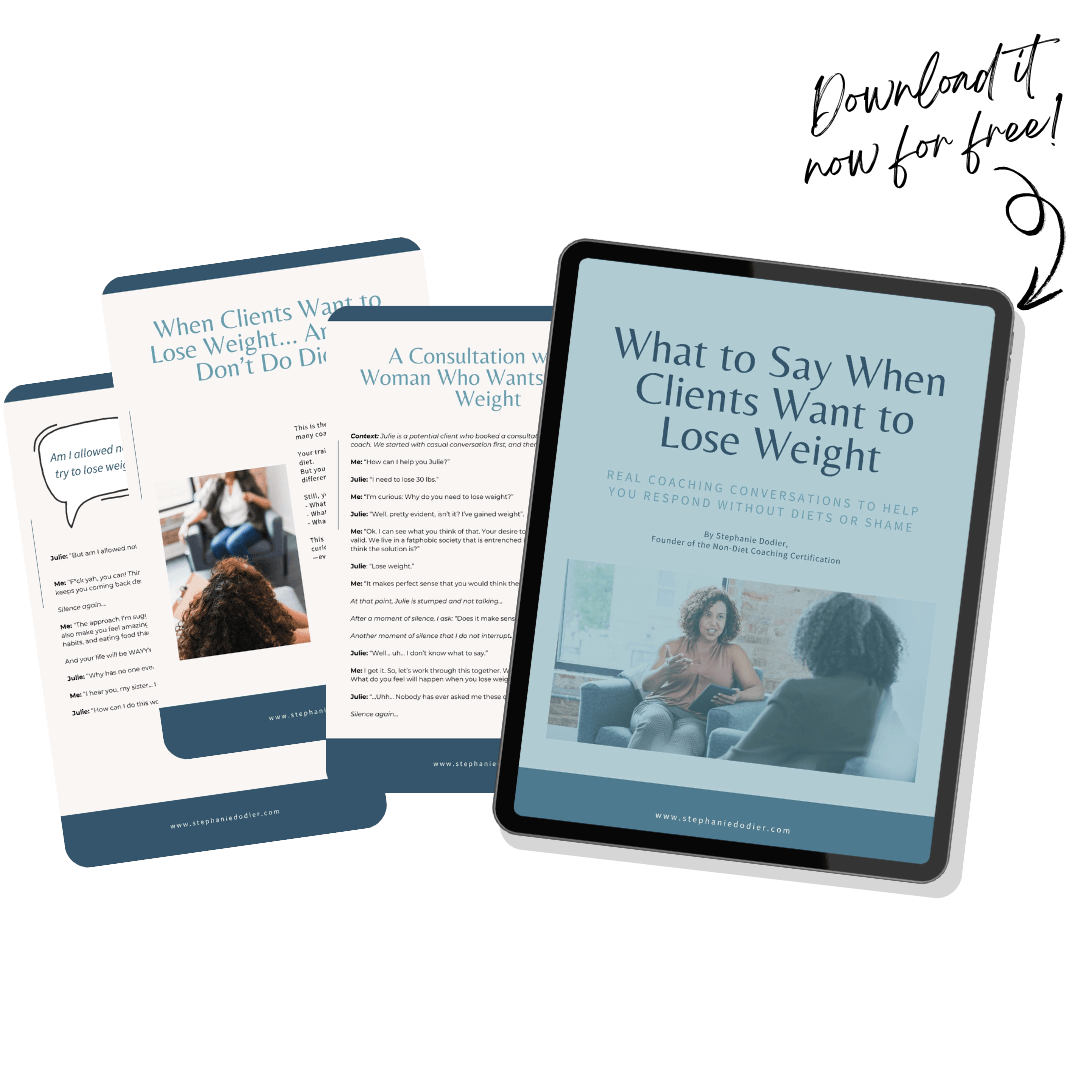

FREE GUIDE
What to say when a client want to lose weight
GET THE EXACT WORDS I USE IN REAL COACHING SESSIONS—WHEN WEIGHT LOSS COMES UP AND I’M HOLDING A WEIGHT-NEUTRAL STANCE


FREE GUIDE
What to say when a client want to lose weight
Get then exact word I use in real coaching session when weight loss comes up and I'm holding a weight-neutral stance
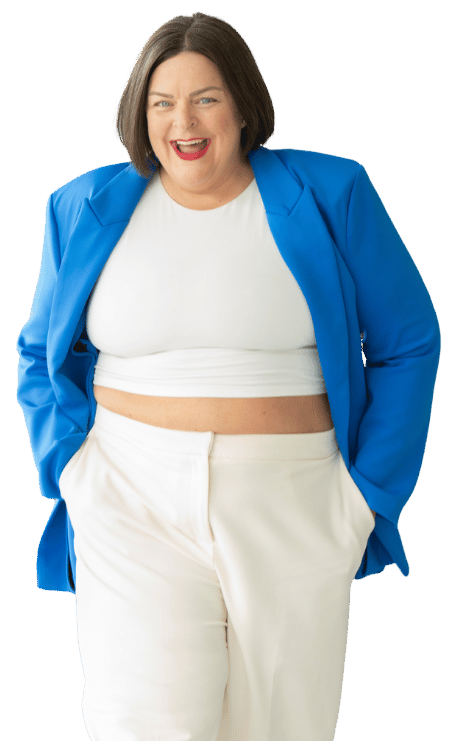

Welcome!
I’m Stephanie Dodier
I am a non-diet nutritionist, educator, and feminist business leader challenging everything we’ve been taught about food, health, and coaching.
I help health professionals confidently coach food and body without co-opting diet culture.
Join me in leading the health coaching revolution!
Ready? Let's do this!

